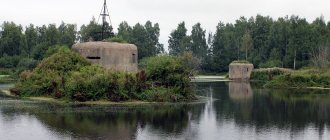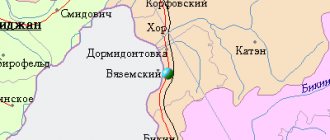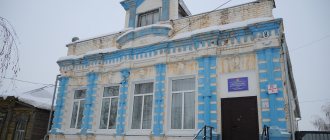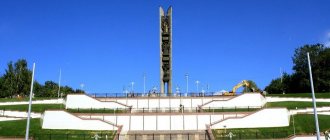This term has other meanings, see Kambarka (meanings).
| City Kambarka Udm. Kambarka
| Coat of arms |
| A country | Russia, Russia |
| Subject of the federation | UdmurtiaUdmurtia |
| Municipal district | Kambarsky |
| urban settlement | Municipal entity "Kambarskoe" |
| Coordinates | 56°16′00″ n. w. 54°12′00″ E. long / 56.26667° north w. 54.20000° E. d. / 56.26667; 54.20000 (G) [www.openstreetmap.org/?mlat=56.26667&mlon=54.20000&zoom=14 (O)] (Z)Coordinates: 56°16′00″ N. w. 54°12′00″ E. long / 56.26667° north w. 54.20000° E. d. / 56.26667; 54.20000 (G) [www.openstreetmap.org/?mlat=56.26667&mlon=54.20000&zoom=14 (O)] (I) |
| Based | in 1767 |
| City with | 1945 |
| Square | 12940 km² |
| Center height | 75 |
| Population | ↘10,577[1] people (2016) |
| Density | 0.82 people/km² |
| Names of residents | kambaryaki, kambaryak, kambaryachka |
| Timezone | UTC+4 |
| Telephone code | +7 34153 |
| Postal codes | 427950-427959 |
| Vehicle code | 18 |
| OKATO code | [classif.spb.ru/classificators/view/okt.php?st=A&kr=1&kod=94220501000 94 220 501 000] |
| Official site | [www.kamrayon.ru/rayon.ru] |
| Kambarka Moscow |
| : Incorrect or missing image Izhevsk Kambarka |
Audio, photo and video
on Wikimedia Commons
K: Settlements founded in 1767
Kambarka
- a city in Russia, the administrative center of the Kambarsky district of the Udmurt Republic. The only one of the six Udmurt cities that has the status of a city of regional subordination.
Previously, it was classified as a “conditionally closed” city (it did not have the status of a closed city, but visiting it by foreigners, and in some cases by Soviet citizens, was prohibited). Near the city there were chemical weapons warehouses with lewisite, the reserves of which were destroyed from 2006 to 2010.
Geography
The city is located in the southeast of the republic, on the Kambarka River, 116 kilometers from the capital of Udmurtia, Izhevsk. And like the entire Kambarsky district, it is separated from the rest of the republic by the Kama River, through which there is a ferry crossing in the summer.
The city is divided into two parts by the Kambarsky pond. On the eastern outskirts of the city there is a natural monument Kambarsky swamp.
Timezone
| The city of Kambarka, like the whole of Udmurtia, is located in the Samara time zone. The offset relative to UTC is +4:00. Relative to Moscow time, the time zone has a constant offset of +1 hour and is designated in Russia as MSK+1. |
It is interesting to note that the meridian 52°30′ E passes through the territory of Udmurtia. d., separating the 3rd and 4th geographical time zones, therefore in the center and in the east (including Kambarka and Izhevsk) the official time corresponds to geographic zone time.
Until March 28, 2010, Udmurtia was in the time zone designated Samara Time (SAMT/SAMST), the offset relative to UTC was +4:00 (SAMT, winter time) / +5:00 (SAMST, summer time).
Kambarka. Zakamye
Our magazine is starting a new series of publications, the purpose of which is to introduce readers to the Udmurt hinterland. We will write about all regions of the republic. And we decided to start with Kambarka. The Kambarsky district is our Udmurt Kaliningrad - the only regional center of the republic (like the entire region), separated from the “mainland” by the Kama River.
Kambarsky district is the smallest in Udmurtia - it occupies only 673 square kilometers. Here is the village of Novokreshchenka, the easternmost inhabited point of our region. In addition, it is also the youngest district. It was first created, then liquidated, then created again. And this happened three times.
The last time the Kambarsky district was revived was in 1966. Over the decades since then, the population of the area has almost halved. Today, just over 16 thousand people live here, and about two-thirds of this number are in the regional center - the small and patriarchal town of Kambarka.
Story
Founding of the city
The founding of Kambarka is associated with the construction of an iron foundry on the Kambarka River. On February 21, 1741, the Ural mining owner Akinfiy Nikitich Demidov bought land from the Bashkirs near the Kambarka River for five. gold rubles. By decree of August 22, 1760, the Berg College allowed the construction of two factories for processing cast iron and a saw mill for sawing timber. In 1761, construction of a dam and hammer factories began and in 1767 the construction of the plant was completed. Gradually the plant expanded, and after it the factory village.
There was a hospital at the plant. In 1863, a primary men's zemstvo school was opened in Kambarka, and in 1872, a women's school. In 1883, the first zemstvo library appeared[2]. Before the revolution, there were three churches in the village: Assumption, Peter and Paul and Holy Trinity, the latter belonged to the Old Believers community of the Belokrinitsky consent.
Until 1923, Kambarka was the center of the Kambarsky volost of the Osinsky district of the Perm province. As a result of the administrative-territorial reform in 1923, the Ural region was formed and the Kambarsky district was formed as part of the Sarapul district of the new region. In 1930, the Sarapulsky district was disbanded, and the following year, 1931, the settlements of the abolished Kambarsky district became part of the Sarapulsky district of the Ural region. In 1934, Kambarka, as part of the Sarapulsky district, was transferred to the Kirov Territory[3].
Workers' village Kambarka
In 1936, Kambarka received the status of a workers' village. In 1937, the future city as part of the Sarapulsky district was transferred from the Kirov Territory to the Udmurt Autonomous Soviet Socialist Republic. In 1939, the Kambarsky district was re-formed[4]. During the Great Patriotic War, 80% of factory workers were drafted into the active army. In 1944, the Kambarsky Foundry and Mechanical Plant was transformed into a machine-building plant.
Kambarka city
In 1945, the working village of Kambarka was transformed into a city of regional subordination[5]. In 1964, a museum of history and culture of the region was opened. The initiator of the creation of the museum was local historian, honorary citizen of the Kambarsky district Pleshakov Petr Aleksandrovich (1901-1987). From 1963 to 1967, Kambarka was again part of the Sarapulsky district, and on January 3, 1967, the Kambarsky district was formed for the third and last time[6].
City from swamp to bridge
The descriptions of Kambarka quite seriously say that this is the only place in Udmurtia where taiga small-fruited cranberries grow. Even more interesting is that the famous cranberry bog, a natural monument, is located right on the territory of the city, namely on its eastern outskirts. The central Lenin Street goes around this swamp like a horseshoe.
The second most important attraction of Kambarka is the already mentioned bridge over the Kama. The road to it begins on the opposite - western edge of the city. The bridge itself is about a kilometer long.
Connoisseurs of history and architecture will certainly be interested in the houses of merchants Shirshov and Vavilov that have been preserved in Kambarka, built at the turn of the 20th century, as well as the house of the last owner of the ironworks, Kondyurin.
In 1855, Kambarka was visited by the famous Russian writer Mikhail Saltykov-Shchedrin, who for eight years was an adviser to the provincial government and, on duty, traveled throughout the Vyatka province. Let us remind you that Mikhail Evgrafovich is one of four official contenders (along with Gogol, Karamzin and Vyazemsky) for the authorship of the catchphrase: “There are two troubles in Russia: fools and roads.”
Before the October Revolution and in the first years after it, Kambarka was a fairly important provincial center, so during the Civil War it often became the scene of significant (on a regional scale) events. So, in September 1918, during the Izhevsk-Votkinsk uprising, the Red Army garrison of Kambarka went over to the side of the rebels in full force. After the suppression of this uprising, from December 1918 to March 1919, it was here that the headquarters of the famous “Iron” 28th division of the Red Army under the command of Vladimir Azin (real name - Voldemar Azins) was located. Even during his lifetime, legends were formed about the 24-year-old division commander, one of the first holders of the Order of the Red Banner. But he only lived until he was 25 years old - he was captured by the White Cossacks and was executed.
Let us recall that the rebel workers of the Izhevsk and Votkinsk factories held a significant part of the territory of present-day Udmurtia in the period from August 8 to mid-November 1918. In memory of these events, both Izhevsk and Kambarka have streets named after the Latvian Azin.
Most descriptions of any cities and towns contain stories about their natives who have achieved all-Russian, or even world-wide fame. Unfortunately, the town of Kambarka and the Kambarsky district are so small that they can boast of only a few such examples.
Thus, Viktor Balakin, a native of the village of Balaki, Kambarsky district, was the mayor of the capital of Udmurtia from 2001 to 2010. A native of the city of Kambarka, Yuri Buzilov is an outstanding Soviet scientist, corresponding member of the All-Russian Academy of Agricultural Sciences. One of the streets of Izhevsk bears the name of Nikolai Korotkov, who was born on Kambar land, in the village of Vedrets. This is a very famous and highly respected civil engineer in the republic, whose merits, among other things, were awarded the title of Hero of Socialist Labor.
Education
In the city there are Lyceum No. 1 named after. N. K. Krupskaya, school No. 2, school No. 3, Kambarsky Mechanical Engineering College, Kambarsky evening (shift) secondary schoolEconomy
Industry- Enterprise "Metallist" - production of household pumps, safes, etc.
- Kambarsky Machine-Building Plant - production of diesel locomotives, track machines for railways and subways.
- The Nika-Petrotek enterprise produces chemicals for oil workers.
- The Mashinostroitel enterprise produces metal structures for the oil industry.
- Industrial and Commercial Enterprise "Dymoff" - production of industrial chimneys and metal structures.
- Enterprise "Lesnoye"
- VCh136 - production of equipment for military chemical purposes and the oil industry.
- In the vicinity of the city there is an enterprise for the destruction of chemical weapons “UKhO 1203”[20].
Transport
Like the entire Kambarsky district, the city is separated from the rest of the republic by the Kama River, through which in the summer, 5 km from Kambarka opposite the village of Tarasovo, there is a ferry crossing.
In winter (from December to March), movement is carried out on the ice of the Kama River; in the off-season, crossing is impossible. The nearest permanent crossings across the river are: upstream - in the Perm Territory in the city of Tchaikovsky, 77 km from the city, downstream - 321 km in the city of Naberezhnye Chelny in the territory of Tatarstan[21]. Since ancient times, there has been a broken dirt road towards Bashkiria, with a toll crossing across the Bui River. A normal road from the city is laid only in the town of Tchaikovsky (Perm Territory). There are no other asphalt roads beyond the Kambarsky district, and therefore during the spring and autumn thaw, the city and the region have no possibility of road communication with the mainland, effectively turning into the “Kambarka Island”. At such a time, you can only get there by train and through the town of Tchaikovsky (Perm Territory). Since October 2013, construction of a road bridge across the Kama River began in close proximity to the city[22][23]. A major route is planned to Bashkiria (Neftekamsk) and to Izhevsk (planned until 2021). The Kazan-Ekaterinburg railway passes through Kambarka, on which there is a railway station on the territory of the city, through which three pairs of electric trains pass Yanaul - Izhevsk.
"Kambarka Island"
It has always been difficult to get to the smallest city of Udmurtia by car. In the summer you had to queue for the ferry across the Kama. In winter, there was an ice crossing on the river. Well, in the off-season, when the ferry was no longer working and the melting ice was still thin, getting to the city had to take a detour through the neighboring Perm region. Because of such difficulties, local residents called their city “Kambarka Island.”
This problem was solved four years ago, when bridges were finally built across the Kama and Bui rivers, which connected Kambarka with the “mainland”. True, the bridge was built under a concession agreement, and it does not provide for free passage even for Kambaryaks. Travel is not cheap - 270 rubles one way by car on the Kama Bridge and 180 rubles on the bridge over Bui. So residents of Kambarka, who do not have high incomes, still prefer the ferry in the summer, and the ferry in the winter.
However, you can not only get to Kambarka by car or swim. In a city that has long produced railway equipment, there is, of course, a railway connection. For example, the railway station building was built according to the standard design of the great architect Alexei Shchusev - the same man who created the Mausoleum of V.I. Lenin in Moscow, as well as the Central Children's Palace of Railwaymen immortalized in the novel “12 Chairs”, and, of course, known to almost every resident Udmurtia, the building of the Kazan (and then Ryazan) station of the Russian capital!
The railway station building was built according to the standard design of the great architect Alexei Shchusev - the same man who created the Mausoleum of V.I. Lenin in Moscow, as well as the Central Children's Palace of Railway Workers immortalized in the novel “12 Chairs”, and, of course, the building known to almost every resident of Udmurtia Kazan (and then Ryazan) station of the Russian capital!
Kambarka station is located on the line connecting Moscow with the Urals and Siberia. Of the numerous long-distance trains passing through the city, three stop here: Izhevsk - Yekaterinburg, Moscow - Barnaul and Kazan - Novy Urengoy...
Toponymy of the city
Streets of Kambarka
- Lenin Street
- Sovetskaya Street
- Pervomaiskaya Street
- Karl Marx Street
- Azina Street (locals call it the Big Progal)
- Dekabristov Street
- Freedom Street
- Labor Street
- Sverdlova Street
- Nikita Manokhin Street
- Gogol street
- Matrosova Street
- Vokzalnaya Street
- Suvorov Street
- Novaya Street
- Nagornaya Street
- Severnaya Street
- Dorozhnaya Street
- Lermontova street
- Barzhevikov Street
- Pogranichnikov Street
- Yuri Kuryagin Street (formerly Oktyabrskaya Street, renamed in honor of Yuri Kuryagin, who lived on this street; Yuri died heroically while performing a combat mission on the territory of the Chechen Republic.)
- Zavodskaya street
- Molodezhnaya Street
- East Street
- Druzhby street
- International street
- Malo-Zelyonaya Street
- Ekipazhnaya Street
- Demidova Street
- Zaprudnaya Street
- Street 40 years of October
- Street 45 Let Pobedy
- Street V/b 136
- Gagarin street
- Herzen Street
- Dekabristov Street
- Dovator Street
- Dorozhnaya Street
- Zheleznodorozhnaya Street
- Zavodskaya street
- Kamskaya street
- Kirova street
- Red Street
- Lazo Street
- Lomonosova Street
- Lugovaya Street
- M. Gorky Street
- Mayakovsky Street
- Michkova Street
- N. Manokhin Street
- Nagornaya Street
- O. Koshevoy Street
- Ozernaya Street
- Partizanskaya Street
- Podlesnaya Street
- Proletarskaya street
- Pugacheva Street
- Pushkin street
- S. Razin Street
- Sverdlova Street
- Severnaya Street
- Sosnovy Bor Street
- Chapaeva Street
- Chernyshevsky Street
- South street
Lanes of Kambarka
- School
- Komsomol
- Nekrasovsky
- Ostrovsky
- Pionersky
- March 8th
- Station
- Sandy
- Mayakovsky
- Prudovskaya
- Ural
- Club
“We survived chemistry, we will survive waste”
“Not all Kambaryak people are against recycling,” notes Yuri Poddubsky. “There are those who say: “We survived chemistry, we will survive waste.” Inertia is noticeable: “What will we do now that Moscow has decided?” Such people have to be convinced. We tell them: “Where are your children and grandchildren? Why don't you think about them?
By the third hour the asphalt on the streets of Kambarka had warmed up, it became dusty and stuffy. We are trying to get passers-by to talk.
“Lewisite was destroyed, everything was fine and normal, no one was indignant,” a conversation began with Svetlana . She's wearing dark glasses and in a wheelchair. She said it was due to an accident. “They say this caused cancer.” It seems to me that this is not true, cancer is progressing everywhere now. And now it's trash. Garbage is a common thing, but everyone rebelled, no one wants this plant to be here. It would be good if additional work appeared for the population of the Kambarsky district. I am outraged that there is no work in Kambarka.
— This production would require chemists. Do you think you have that many chemists?
- Certainly. I am a chemist myself, I worked at a factory.
— Did you work on the destruction of lewisite?
- Yes, from the very beginning.
“You understand that it was destroyed on the spot, because it cannot be taken out.” And it is not necessary to bring garbage to Kambarka.
- Not necessary. But I believe that the harmful effects of waste disposal are exaggerated. I am for there to be work. There is nowhere for men to work.
- Do you think they will be ready for dirty work?
- Why not, we have to feed our families.
| This building houses the administration of the district, city and councils of deputies. |
In the cool and half-asleep offices, the administration managed to find only the head of the Kambarskoye municipal organization, Nikolai Shulepov .
“If the CWD facility is abandoned, then there will be no soil reclamation and no destruction of what is there,” head Nikolai Shulepov shared his opinion. — When there is repurposing, the first condition will be complete reclamation, to the point of leaving only walls in the buildings, demolishing the ground down to half a meter. Let the experts determine what to do there. It will be worse if everything is abandoned.
— Were you at the rally? At the meeting, Kambaryak residents were able to express their opinion on re-profiling. What do you think about the town meeting?
— Every citizen has the right to express their opinion, but I believe that there should be a survey so that 100 percent of residents can express their opinion. There were 300 people there, I walked by and looked, but there were 9 thousand inhabitants.
— Then do we need a referendum?
- This is possible. Let then those who initiate the rallies hold a referendum and find out what the residents think.
Excerpt characterizing Kambarka
“Despite my complete respect for old Kutuzov,” he continued, “we would all be good if we waited for something and thereby gave him a chance to leave or deceive us, whereas now he is surely in our hands.” No, we must not forget Suvorov and his rules: do not put yourself in the position of being attacked, but attack yourself. Believe me, in war, the energy of young people often shows the path more accurately than all the experience of the old cunctators. – But in what position do we attack him? “I was at the outposts today, and it is impossible to decide where exactly he is standing with the main forces,” said Prince Andrei. He wanted to express to Dolgorukov his plan of attack that he had drawn up. “Oh, it doesn’t matter at all,” Dolgorukov quickly spoke, standing up and revealing the card on the table. - All cases are foreseen: if he stands at Brunn... And Prince Dolgorukov quickly and clearly explained the plan for Weyrother’s flank movement. Prince Andrei began to object and prove his plan, which could be equally good with Weyrother’s plan, but had the drawback that Weyrother’s plan had already been approved. As soon as Prince Andrei began to prove the disadvantages of him and the benefits of his own, Prince Dolgorukov stopped listening to him and absentmindedly looked not at the map, but at the face of Prince Andrei. “However, Kutuzov will have a military council today: you can express all this there,” said Dolgorukov. “That’s what I’ll do,” said Prince Andrei, moving away from the map. - And what are you worried about, gentlemen? - said Bilibin, who had been listening to their conversation with a cheerful smile and now, apparently, was about to make a joke. – Whether there is victory or defeat tomorrow, the glory of Russian weapons is insured. Apart from your Kutuzov, there is not a single Russian commander of the columns. Chiefs: Herr general Wimpfen, le comte de Langeron, le prince de Lichtenstein, le prince de Hohenloe et enfin Prsch... prsch... et ainsi de suite, comme tous les noms polonais. [Wimpfen, Count Langeron, Prince Liechtenstein, Hohenlohe and also Prishprshiprsh, like all Polish names.] - Taisez vous, mauvaise langue, [Hold your evil tongue.] - said Dolgorukov. – It’s not true, now there are already two Russians: Miloradovich and Dokhturov, and there would be a 3rd, Count Arakcheev, but his nerves are weak. “However, Mikhail Ilarionovich, I think, came out,” said Prince Andrei. “I wish you happiness and success, gentlemen,” he added and left, shaking hands with Dolgorukov and Bibilin. Returning home, Prince Andrei could not resist asking Kutuzov, who was silently sitting next to him, what he thought about tomorrow’s battle? Kutuzov looked sternly at his adjutant and, after a pause, answered: “I think that the battle will be lost, and I told Count Tolstoy so and asked him to convey this to the sovereign.” What do you think he answered me? Eh, mon cher general, je me mele de riz et des et cotelettes, melez vous des affaires de la guerre. [And, dear general! I’m busy with rice and cutlets, and you are busy with military affairs.] Yes... That’s what they answered me! At 10 o'clock in the evening, Weyrother with his plans moved to Kutuzov's apartment, where a military council was appointed. All the commanders of the columns were requested to see the commander-in-chief, and, with the exception of Prince Bagration, who refused to come, everyone appeared at the appointed hour. Weyrother, who was the overall manager of the proposed battle, presented with his liveliness and haste a sharp contrast with the dissatisfied and sleepy Kutuzov, who reluctantly played the role of chairman and leader of the military council. Weyrother obviously felt himself at the head of a movement that had become unstoppable. He was like a harnessed horse running away downhill with its cart. Whether he was driving or being driven, he did not know; but he rushed as fast as possible, no longer having time to discuss what this movement would lead to. Weyrother that evening was twice for personal inspection in the enemy’s chain and twice with the sovereigns, Russian and Austrian, for a report and explanations, and in his office, where he dictated the German disposition. He, exhausted, now came to Kutuzov. He, apparently, was so busy that he forgot to even be respectful to the commander-in-chief: he interrupted him, spoke quickly, unclearly, without looking into the face of his interlocutor, without answering the questions asked of him, was stained with dirt and looked pitiful, exhausted, confused and at the same time arrogant and proud. Kutuzov occupied a small noble castle near Ostralitsy. In the large living room, which became the office of the commander-in-chief, gathered: Kutuzov himself, Weyrother and members of the military council. They were drinking tea. They were only waiting for Prince Bagration to begin the military council. At 8 o'clock Bagration's orderly arrived with the news that the prince could not be there. Prince Andrei came to report this to the commander-in-chief and, taking advantage of the permission previously given to him by Kutuzov to be present at the council, remained in the room. “Since Prince Bagration will not be there, we can begin,” said Weyrother, hastily getting up from his place and approaching the table on which a huge map of the surrounding area of Brünn was laid out. Kutuzov, in an unbuttoned uniform, from which, as if freed, his fat neck floated out onto the collar, sat in a Voltaire chair, placing his plump old hands symmetrically on the armrests, and was almost asleep. At the sound of Weyrother's voice, he forced his only eye open. “Yes, yes, please, otherwise it’s too late,” he said and, nodding his head, lowered it and closed his eyes again. If at first the members of the council thought that Kutuzov was pretending to be asleep, then the sounds that he made with his nose during the subsequent reading proved that at that moment for the commander-in-chief it was about much more important than the desire to show his contempt for the disposition or for anything else. be that as it may: for him it was about the irrepressible satisfaction of a human need - sleep. He was really asleep. Weyrother, with the movement of a man too busy to waste even one minute of time, looked at Kutuzov and, making sure that he was sleeping, took the paper and in a loud, monotonous tone began to read the disposition of the future battle under the title, which he also read: “Disposition for attack of the enemy position behind Kobelnitsa and Sokolnitsa, November 20, 1805." The disposition was very complex and difficult. The original disposition included: DA Der Feind Mit Seinerien Linken Fluegel An Die Mit Wald Bedecten Berge Lehnt Sich Mit Seinerien Fluegs Kobeinitz Und Sokolienitz Hinter Die Dort BEFIND IChen Teiche Zieht, Wir IM Geegentheil Mit Unserem Linken Fluegel Seineen Rechten Sehr DeboDiren, So Ist es vortheilhaft letzteren Fluegel des Feindes zu attakiren, besondere wenn wir die Doerfer Sokolienitz und Kobelienitz im Besitze haben, wodurch wir dem Feind zugleich in die Flanke fallen und ihn auf der Flaeche zwischen Schlapanitz und dem Thuerassa Walde verfolgen koennen, indem wir dem De filen von Schlapanitz und Bellowitz ausweichen, welche die feindliche Front decken. Zu dieserien Endzwecke ist es noethig... Die erste Kolonne Marieschirt... die zweite Kolonne Marieschirt... die dritte Kolonne Marieschirt... [Since the enemy rests his left wing on the forest-covered mountains, and his right wing stretches along Kobelnitsa and Sokolnitsa behind the ponds located there, and we On the contrary, if our left wing surpasses his right wing, then it is advantageous for us to attack this last enemy wing, especially if we occupy the villages of Sokolnits and Kobelnits, being given the opportunity to attack the enemy’s flank and pursue him in the plain between Shlapanits and the Tyuras forest, avoiding with those defiles between Shlapanitz and Belowitz, which covered the enemy front. For this purpose it is necessary... The first column marches... the second column marches... the third column marches...], etc., Weyrother read. The generals seemed reluctant to listen to the difficult disposition. The blond, tall General Buxhoeveden stood with his back against the wall, and, fixing his eyes on the burning candle, it seemed that he was not listening and did not even want to be thought that he was listening. Directly opposite Weyrother, fixing his shining open eyes on him, in a militant pose, resting his hands with his elbows outstretched on his knees, sat the ruddy Miloradovich with his mustache and shoulders raised. He remained stubbornly silent, looking into Weyrother’s face, and only took his eyes off him when the Austrian chief of staff fell silent. At this time, Miloradovich looked significantly back at the other generals. But from the meaning of this significant glance it was impossible to understand whether he agreed or disagreed, was pleased or dissatisfied with the disposition. Count Langeron sat closest to Weyrother and, with a subtle smile of a southern French face that did not leave him throughout the reading, looked at his thin fingers, quickly turning the corners of a golden snuffbox with a portrait. In the middle of one of the longest periods, he stopped the rotating movement of the snuffbox, raised his head and, with an unpleasant politeness at the very ends of his thin lips, interrupted Weyrother and wanted to say something; but the Austrian general, without interrupting his reading, frowned angrily and waved his elbows, as if saying: later, then you will tell me your thoughts, now if you please look at the map and listen. Langeron raised his eyes upward with an expression of bewilderment, looked back at Miloradovich, as if looking for an explanation, but, meeting Miloradovich’s significant, meaningless gaze, he sadly lowered his eyes and again began to twirl the snuffbox. “Une lecon de geographie, [A lesson from geography,"] he said as if to himself, but loud enough to be heard. Przhebyshevsky, with respectful but dignified courtesy, bent his ear to Weyrother, looking like a man absorbed in attention. Small in stature Dokhturov sat directly opposite Weyrother with a diligent and modest look and, bending over the laid out map, conscientiously studied the dispositions and the terrain unknown to him. Several times he asked Weyrother to repeat the words he had heard poorly and the difficult names of the villages. Weyrother fulfilled his wish, and Dokhturov wrote it down. When the reading, which lasted more than an hour, was over, Langeron, again stopping his snuff-box and without looking at Weyrother or anyone in particular, began to talk about how difficult it was to carry out such a disposition, where the position of the enemy is supposed to be known, whereas this position could be we do not know, since the enemy is on the move. Langeron's objections were well-founded, but it was obvious that the purpose of these objections was primarily the desire to make General Weyrother feel, as self-confidently as schoolchildren reading his disposition, that he was dealing not only with fools, but with people who could learn in military affairs. When the monotonous sound of Weyrother’s voice fell silent, Kutuzov opened the chapter, like a miller who wakes up during a break in the soporific sound of the mill wheels, listened to what Langeron was saying, and, as if saying: “And you’re still talking about this nonsense!” hastily closed his eyes and lowered his head even lower. Trying to insult Weyrother in his author's military pride as sarcastically as possible, Langeron argued that Bonaparte could easily attack, instead of being attacked, and as a result make this whole disposition completely useless. Weyrother responded to all objections with a firm, contemptuous smile, obviously prepared in advance for any objection, no matter what they said to him. “If he could attack us, he would do it today,” he said. “You therefore think that he is powerless,” said Langeron. “A lot, if he has 40 thousand troops,” Weyrother answered with the smile of a doctor to whom a doctor wants to indicate a cure. “In this case, he is going to his death, waiting for our attack,” Langeron said with a thin ironic smile, looking back at the nearest Miloradovich for confirmation. But Miloradovich, obviously, at that moment was thinking least of all about what the generals were arguing about. “Ma foi, [By God,” he said, “tomorrow we will see everything on the battlefield.” Weyrother grinned again with that smile that said that it was funny and strange for him to meet objections from the Russian generals and to prove what not only he himself was too sure of, but what the emperors were sure of. “The enemy has put out the fires, and a continuous noise is heard in his camp,” he said. - What does it mean? “Either he moves away, which is the only thing we should be afraid of, or he changes his position (he grinned). But even if he took a position in Tyuras, he only saves us from a lot of trouble, and all the orders, down to the smallest detail, remain the same.
Latrine places
On April 30, Prime Minister Dmitry Medvedev signed Resolution No. 540 “On budgetary investments from the federal budget in capital construction projects within the framework of the federal project “Infrastructure for waste management of I-II hazard classes.”
Rosatom was appointed as the state customer for the construction of waste management infrastructure, and FSUE Radioactive Waste Management Enterprise RosRAO was appointed as the developer.
To continue reading, click "Read More".
The government decided to invest 20.4 billion rubles in four complexes - Maradykovsky, Shchuchye, Gorny and Kambarka. Each production and technical complex must dispose of up to 50 thousand tons of hazardous waste per year. The facilities will be commissioned in 2023.
All the facilities are former chemical weapons storage facilities, where these weapons were disposed of until 2005. “Maradykovsky” is located near the village of Mirny in the Orichevsky district of the Kirov region, “Shchuchye” in the Kurgan region, “Gorny” in the Saratov region, “Kambarka” in the Udmurt Republic. Activists aptly defined the geographical location of the complexes as the “Ring of Death”.
In addition to Kambarka, in Udmurtia there is another facility for the storage and destruction of chemical weapons - a plant in Kizner. This plant disposed of 2 million artillery shells containing organophosphates. After the completion of the chemical weapons destruction program, they wanted to move the gunpowder plant from Kazan to Kizner, but in 2021 Rosatom was already planning to locate hazardous waste disposal facilities there. Two production and technical complexes in one region are too much, Kambaryak residents are outraged.









